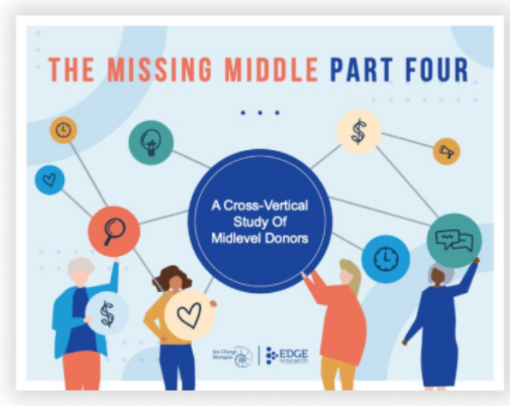Fat on the Ends, Skinny in the Middle
Here at The Agitator, we don’t subscribe to the “we told you so” mindset.
BUT…14 years ago we alerted readers to what looked like both an anatomical and fundraising failure on the part of too many nonprofits. In June of 2010 our post Cashing in on The Chasm noted, “ the much-vaunted “Fundraising Pyramid” too often resembles an hourglass. Fat on the ends, skinny in the middle.”
We were, of course, speaking of the scarcity of Mid-Level programs.
As the name implies, Mid-Level or Middle Donor Programs are fundraising and communications efforts that fall between the mass (smaller gift) efforts at the base of the Pyramid and the large (major gifts) at the top. Mid-Level giving ranges vary depending on how you want to define them, but usually they’re in the $500 to $5,000 + range.
And we warned, “Frankly, at a time when many groups are having acquisition and retention trouble at the base of the pyramid and uncertain economic times are creating delays or deferrals in giving at the top, the middle is where fundraisers need to focus.”
 In short, rather than thinking of building your funding edifice in the shape of an hourglass it’s way past time to be thinking about the importance of employing the “keystone” in the architecture of your fundraising program.
In short, rather than thinking of building your funding edifice in the shape of an hourglass it’s way past time to be thinking about the importance of employing the “keystone” in the architecture of your fundraising program.
Way back then our thinking was seconded by Mark Rovner, a principal in SeaChange Strategies who, when asked why so many organizations ignored the importance of Mid-Level told the Chronicle of Philanthropy the most plausible explanation lay in “the tension that exists between direct mail fundraisers and major gift fundraisers.
“They genuinely dislike one another,” Mark told Nicole Wallace at The Chronicle. “That’s not true everywhere, but it’s often true. The high-dollar people see the direct marketers as the used-car salesmen of fund raising, and the direct marketers see the high-dollar people as snobs who, if you’re not worth millions of dollars, you’re not worth my time.”
The result of this intra-mural pettiness? Middle donors fall into a chasm of neglect. Meanwhile the needs of the non-profit go unmet and fundraising opportunities unrealized. Of course, The Agitator then weighed in with the recommendation, “if the person in charge of development and fundraising at your organization permits or, worse still, encourages competition between types of giving, or permits fundraising efforts to exist in silos she/he ought to be fired. Or at least put under adult supervision.”
Fortunately, attention to Mid-Level giving didn’t get bogged down over in the human resource silo.
In 2014 Mark and his partner Alia McKee at SeaChange launched the first of a series of what would become a decade-long series of studies on Mid-Level giving. The report titled, “The Missing Middle: Neglecting Middle Donors is Costing You Millions” and all their subsequent reports are downloadable without charge at this Seachange link.
Last week SeaChange issued the Fourth of its Missing Middle series. It’s by far, their most in depth and nuanced look at the ins and outs of Mid-Level giving. Download, read and heed for FREE here.
Missing Middle: Part 4 in a Nutshell
The report surveyed 5,900 Mid-Level donors across 36 organizations and spotlights their key traits and motivations. The research was conducted by SeaChange in partnership with Edge Research.
research was conducted by SeaChange in partnership with Edge Research.
- Although Mid-Level donors often represent only 1 to 5 % of a donor file, they contribute 25 to 35 % of the revenue.
- Obviously, this is where every organization should be spending significant time and money on retention and upgrading.
- 31% of these donors have made a bequest and 23% are considering one.
- 53% of these Mid-Level folks have been giving to the organization for more than 10 years.
- They tend to be older. 61% are baby boomers and 21% from the “silent generation” [born between 1928 and 1945; there are still 19 million of us around; gratuitous note from the Agitator], 13% Gen X and 5% Millennials and GenZ.
- 59% of Mid-Level donors identify as women, 39% as men and 3% chose not to answer that survey question.
- What struck us is the fact that 42% of these Mid-Level folks first became engaged with the cause when they were younger (ages 20-39).
The Necessity of Taking the Long View
Clearly, while it’s certainly important to court younger donors, please note building a successful program requires long-term engagement and long-term thinking. As SeaChange Partner Alia McKee warns, “Folks are measuring long-term engagement in 12-month cycles”, she says. “They’re making strategic decisions to cut those programs because they’re not seeing the return versus really taking a long view at what that relationship will look like when that donor ages into their prime giving years. Consider their lifetime value, including midlevel planned gifts, IRA gifts, all of the constellation of activities that folks will age into if you can keep them.”
Well, for the last 10 years I’ve “aged into” studying and comparing the series of SeaChange reports over the years. And I gotta say, they get sharper and sharper and the advice, better and better.
Having witnessed and chronicled giving during the COVID-19 pandemic and mindful of the fast-changing demographics in the US the authors have these three pieces of advice.
- Make your website easy to navigate. Nearly 40% of Mid-Level donors visit a nonprofit’s website when researching the organization. Yet too many organizations have lost focus on their website. Alia notes “It’s the doorway to your organization but too many websites are too confusing. Donors aren’t sure where to go.”
- Stop bragging about Efficiency. For years we’ve noted that “cost-of-fundraising” and “efficiency” are largely bullshit. Mark Rovner says, “Charities have trained older generations to focus too much on overhead and should stop bragging about your efficiency numbers.” Alia McKee adds, “if donors ask about overhead, share the data. But also educate them about operating costs and reset expectations on overhead.
- Diversify donors. According to this study 89% of Mid-Level donors are white. The authors say this is a “big problem” because it leaves out many people who might support the cause. The add, “the data is a wake-up call for organizations to broaden their internal makeup, the makeup of their staff and their boards so they attract donors of color.
Again, I urge you to download and dig into the report. It contains a treasure trove of information on donor advised funds…demographics, stewardship and engagement, examples of successful techniques and programs.
And while you’re at it, please start visualizing “keystone”, not “hourglass.”
Roger
P.S. We’ll be sending along an Agitator Raise to Mark, Alia and all the folks at SeaChange and Edge Research for keeping the awareness and momentum for Mid-Level giving going and growing for an entire decade. Thank you.



Thank you, too many to name.
Thank you Mark, Alia, Roger et al. We’ve been beating this drum like Keith Moon.
Great article! Thanks Roger, glad to see your take on this. We tracked Mark and Alia’s report carefully and sent it to our consulting team – and our clients!